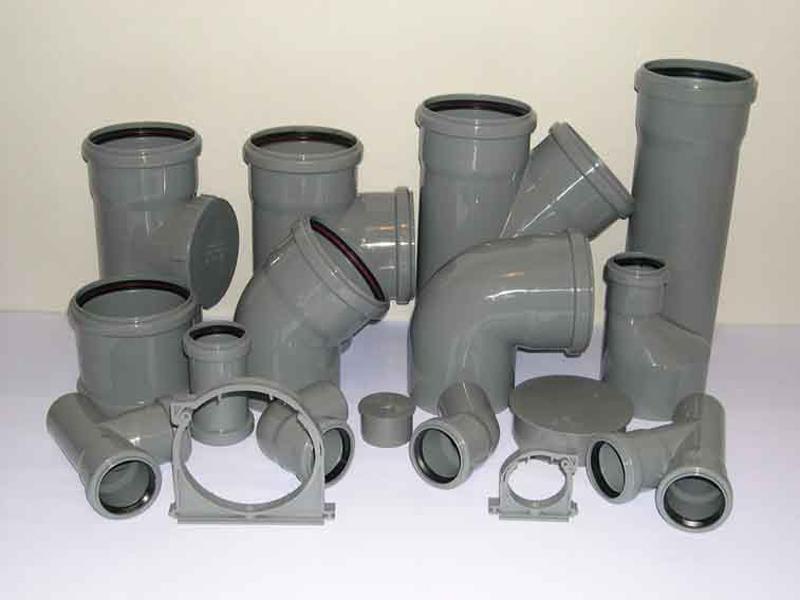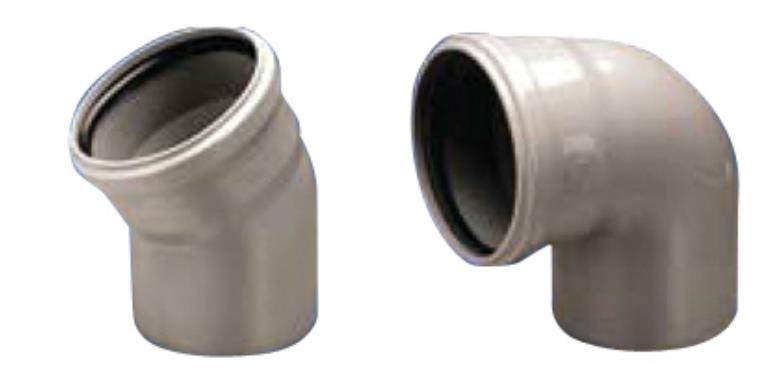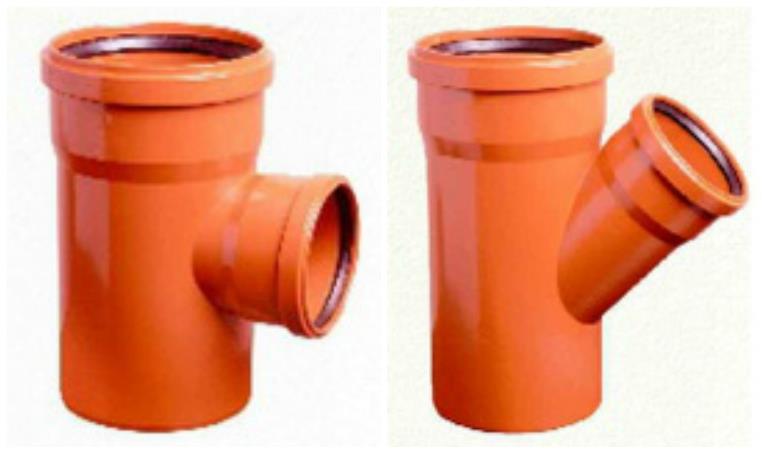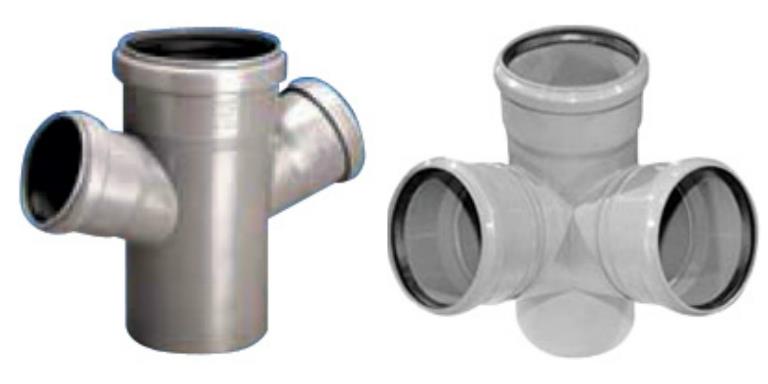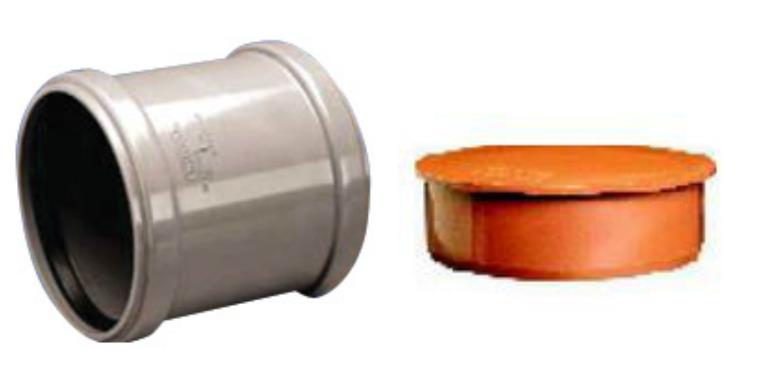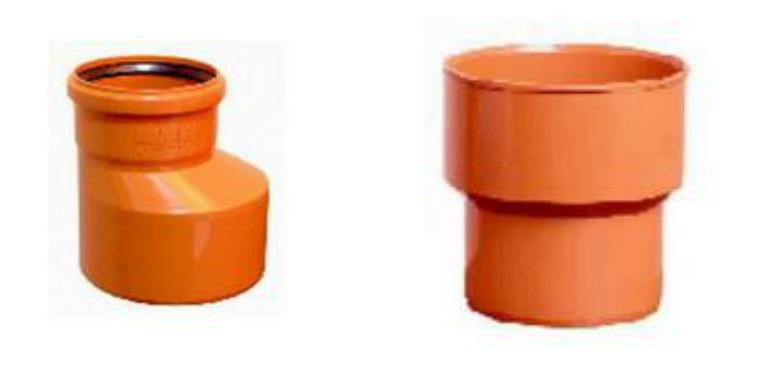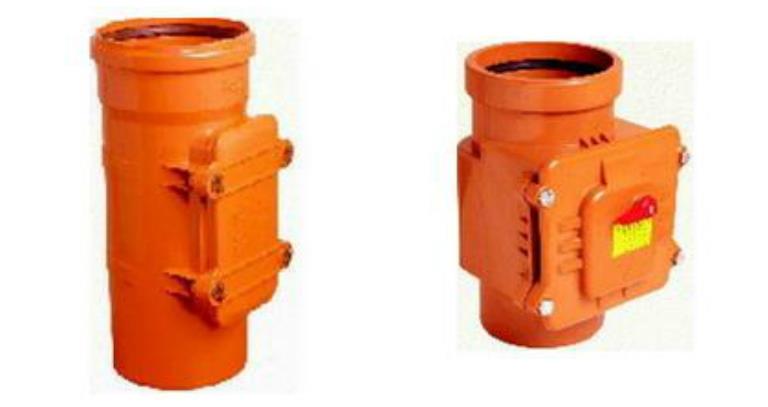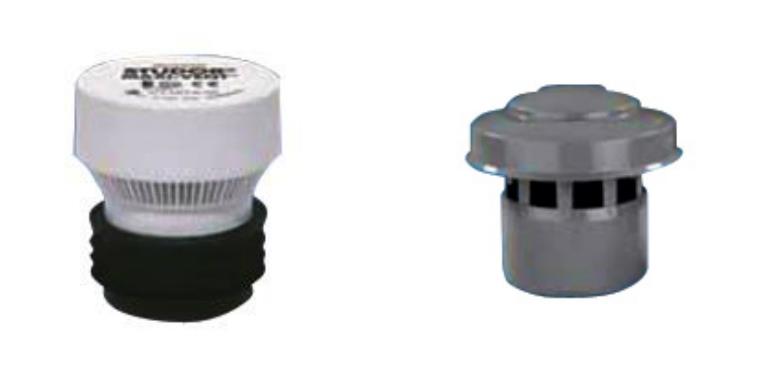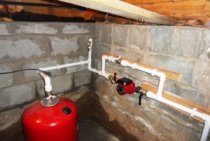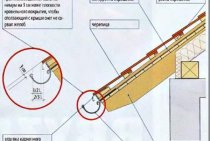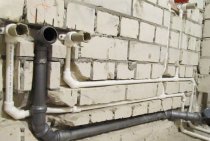The use of pipeline elements for various types of sewerage
Fittings for internal sewerage
The internal sewerage system is laid before the arrangement of the water supply. When laying an internal sewage system, it should be borne in mind that hot water can be discharged into the system from a dishwasher or sink.
Fittings must withstand temperatures up to 75°C (up to 95°C is allowed for a short time). Polypropylene has these properties.
Fittings made of polypropylene are resistant not only to high, but also to low temperatures (no cracking occurs during freezing). When assembling all elements of the pipeline, it is necessary to take into account the expansion of the material when discharging hot water, so the parts are not connected “to the stop”. The smooth inner surface prevents deposits from sticking to the walls, which prevents the formation of blockages.
Polypropylene fittings for internal sewerage
The internal sewerage system also uses compression fittings, which usually come with equipment (for example, a water heater).
The use of compression fittings allows you to connect pipeline elements without soldering, welding and gluing. Only two keys are used for connection, and dismantling is done with just one key.
Fittings for outdoor sewerage
For laying the external sewage system, pipes and fittings made of PVC are used. The fittings of PVC sewer pipes, due to their high ring rigidity, withstand soil pressure, and under the influence of sewage and ground water are not amenable to destruction from the inside and outside. O-rings located in the sockets give the system tightness. The system is easily mounted and dismantled if necessary.
Using pipes and fittings for PVC sewer pipes for laying pipelines, you save not only during construction, but also in the future, since the system will not require maintenance and repair costs for many years of operation.
Fitting classification
Shaped parts are subdivided depending on the purpose.
Elbows (corners) change the direction of the structure at an angle of 45o, 90o, 120o. The pipeline route can change both vertically and horizontally. A socket with a sealing ring on one side.
Branch flexible is applied in system of the internal sewerage. It is used when it is impossible to use standard parts, as the pipeline has a slight bend. A socket with a gasket is located on one side.
Plastic bends for sewer pipes
The tee allows you to make a tap from the main pipeline and can be of the following types:
- Straight tee (angle 90°C) with sockets on both sides, into the grooves of which sealing rings are inserted. A pipe of smaller diameter is inserted into the socket of the branch. The straight part of the tee is inserted into the socket of the pipe to be connected.
- An oblique tee (angle 45°C) with sockets on the branch and on one side of the element. Tees for sewer pipes oblique are used in cases where it is necessary to branch at an angle.
Tees: straight and oblique
The cross provides retraction in two directions:
- A single-plane cross is used when it is necessary to install two branches in the same plane.
- Two-plane sewer pipe crosspiece connects pipelines located in two planes.
Crosses: one- and two-plane
The coupling connects pipes of the same diameter on a straight span.On both sides there are sockets with grooves into which sealing rings are inserted. Connects two straight pieces of pipe. They are used in the repair of a part of the pipeline, when the damaged part of the pipe is removed, a new segment is put in, then connected with a coupling. A sleeve with corrugation (flexible elbow) is used to connect with a bend in the internal sewerage system.
A plug for a sewer pipe closes the end. It is applied at repair, replacement of parts of pipelines. Covering the end of the pipe prevents runoff and odors from entering the room where the system is being disassembled and assembled.
Coupling (left) and plug (right)
The adapter is used to connect pipes of different diameters:
- The eccentric is put on with a straight part on a pipe of a larger diameter, a pipe of a smaller diameter is inserted into the socket with a sealing ring.
- The transition from a plastic pipe to a cast iron pipe is carried out using adapters for sewer pipes.
Cam (left) and cast iron-plastic adapter (right)
The revision provides access to the pipeline from the inside. The lid can be easily removed and sealed. It is installed for the prevention and care of the system in easily accessible places. Bell on one side, the other side is straight.
The check valve on the sewer pipe protects against sewage leaks. Overfilling the system leads to pressure on the membrane, which closes the damper. The damper prevents effluents from moving up the pipeline. There is a possibility of emergency shutdown of the system. The tight cover is removed and allows to make cleaning of the valve.
Revision and non-return valve
Air anti-vacuum valve (sewer aerator) is designed to prevent the ingress of gases from the sewerage system. It is installed at the highest point of the vertical riser. If there is a pressure drop in the pipeline, the valve is bled off. Thanks to the installation of the valve, there is no disruption of the hydraulic seals.
The ventilation umbrella serves to protect the system from the ingress of debris and other contaminants and is installed in the upper riser (displayed on the roof).
Air valve (left) and ventilation hood (right)
What are pipe fittings
Not a single building, where a person carries out his life, can do without the organization of a water supply system. Delivery of vital moisture to the consumer is carried out through a pipeline.
Naturally, when organizing a piping system, it is impossible to get by with just a straight pipe. To distribute the water supply system on all floors of the building and connect each consumer to it, it is necessary to provide it with shaped parts.
Pipeline components
The fittings of the pipeline are auxiliary parts that complete the water supply system. They provide reliable pipe connections, bends and ramifications, and many other functions.
From this we can conclude that the fittings are designed to assemble the entire pipeline system together and give it the necessary angles of rotation and outlets for each individual user. Even if your pipeline is a straight pipe, then you cannot do without connecting elements at its ends.
What types are
The main purpose of the fittings of the pipeline & ensuring a reliable connection of all its elements.
According to their purpose, shaped products are divided into the following types:
- transitional, which provide the connection of pipes of different diameters;
- cross, which allow you to organize several branches in the pipeline;
- tee, with the help of which branches are connected;
- branch, which provide a turn of the pipeline system by 90 degrees;
- branch pipe, which are designed for the installation of special fittings.
Shaped products can be manufactured with different thicknesses of the working wall.These dimensions depend on the conditions for which and for how long the operation of a particular pipeline system is intended.
Which material is better
The fittings of the pipeline are made of steel, cast iron and plastic. Depending on the material and design features of the product, various methods of connecting them with pipeline elements are used.
When organizing a piping system in residential buildings, fittings made of plastic have recently become very popular. They have a lower price and are not subject to corrosion.
Fittings for pipelines
The specification given to you is incorrect. The designers did not want to consider the style, so they wrote complete with fittings,
Since most of the time is just spent on their calculation. You yourself will not count, and if you start, then a lot of time will go away, but also what a responsibility. Therefore, I propose a solution only such that there are no problems with a steel pipe: you take the cost and laying the pipeline.
With polypropylene pipes, the installation is indicated, and the cost is taken according to the price list of the pipes with an increase of 10 percent.
And there, when the work will be done, get better
K category: Types of water pipes
Fittings&pipes
Fittings with anti-corrosion protection are used when making turns, transitions from one pipe diameter to another, branches. They are used when connecting various types of pipes:
– steel electric-welded pipes with a spiral seam with a diameter of 254 mm, with an anti-corrosion ethinol coating;
– steel thin-walled spiral-seam pipes with a diameter of 254 mm with a double-sided zinc coating;
- steel pipes having a wall thickness of 168-1220 mm;
- steel thin-walled electric-welded pipes with a diameter of 168-426 mm with a spiral seam;
– steel thin-walled pipes with a diameter of 200-400 mm with a lacquer-etinol coating;
- asbestos-cement pipes with a diameter of 150-500 mm;
- polyethylene pipes with a diameter of 160-300 mm;
- cast-iron pipes with a diameter of 150-400 mm.
To connect pipes, transitions, tees, bends, crosses and branch pipes are used.
Transitions are used in pipelines to make transitions from one pipe diameter to another.
Tees are used for arranging branches on pipelines. They are equal and transitional.
Elbows are used to turn pipelines at an angle of 90 °.
Rice. 1. Transition: 1 - sleeve-2 - transition; 3 - bell
The content of the work
5. PIPELINE FITTINGS
5.1. BENDS
Elbows are used as inserts in places where pipelines turn at a certain angle. Three types of bends are most common: seamless, curved and sectional bends. They are designed for pressure up to 10 MPa and are made of steel grades 20, 10G2 and 09G2S.
Steeply curved seamless bends are made from sections of steel pipes at various angles of rotation.
Rice. 5.1. Branches are steeply curved seamless.
Bent bends are made on pipe bending machines of cold and hot flexible, including those with HDTV heating, bends with a radius of less than 2Dn bent only with heat. Carbon steel elbows are standardized.
It is allowed to use bends with other α and R in accordance with the instructions of the project documentation. The bending radius is taken from the Rα10 series according to GOST6636-69, and l and lR determined by the formulas:
l=Rtg.; lR = 0.0175 Ra.
Rice. 5.2. Leads are bent.
The mass of the outlet, kg, is determined by the formula
where q is the linear density of the billet pipe, kg/m;
l1 and l2 - set in the design documentation, taking into account the conditions of manufacture, transportation and installation, but not less than 100 mm.
Nominal pressure Pat accepted, as for billet pipes, if the wall thickness on the curved section corresponds to that calculated by the formula
where s is the minimum wall thickness of billet pipes, mm.
Sectional bends are made by welding sectors and half-sectors cut from seamless or electric-welded pipes. Sectional bends made of carbon steel are manufactured according to OST 36-43-81 with Dat. up to 400 mm and according to OST 36-21-77 with Dat = 500 - 1400 mm.
—
CAUTION 1
ФаÑоннÑе ÑаÑÑи ÑÑÑбопÑоводов Ð Ð ÐμÐñññÐðÐ Ð Ð Ð Ð Ð Ð Ð Ð Ð Ð Ð Ð ² Ð Ð Ð Ð Ð Ð ²Ð½ðð¸¸ððð »» »¸¸¸¸¸¸¸¸¸¸¸¸¸¸ Ð Ð Ð Ð Ð Ð Ð Ð μm Ð Ð Ð Ð Ð Ð Ð Ð Ð Ð Ð Ð Ð μm ¸Ð»Ð¸Ñ.
a
ФаÑоннÑе ÑаÑÑи ÑÑÑбопÑоводов - ñð ñð¶ð Ð Ð Ð Ð Ð Ð Ð Ð Ð Ð Ð Ð Ð Ð Ð Ð Ð Ð Ð Ð Ð ÐμÐ Ð Ð Ð ÐμÐ'ñññ¸¸ Ðμ Ð Ð Ð Ð Ð Ð Ð Ð Ð Ð Ð Ð Ð Ð Ð Ð Ð ÐμÐ Ð Ð Ð Ð Ð Ð Ð Ð Ð Ð Ð Ð Ð Ð Ð Ð Ðμ Ð Ð Ð Ð Ð Ð Ð Ð ÐμÐ Ð Ð Ð Ð Ð Ð Ð Ð Ð Ð Ð Ð Ð Ð Ð Ð Ð Ð Ð Ð Ð Ð Ð Ð Ð Ð Ð Ð Ð Ð Ð Ð Ð Ð Ð Ð Ð Ð Ð Ð Ð Ð Ð Ð Ð Ð Ð Ð Ð Ð Ð Ð Ð Ð Ð Ð Ð Ð Ð Ð Ð Ð Ð Ð Ð Ð Ð Ð Ð Ð Ð Ð Ð Ð Ð Ð Ð Ð Ð Ð ' меÑÑа.
a
ФаÑоннÑе ÑаÑÑи ÑÑÑбопÑоводов, Ð Ð Ð Ð Ð Ð Ð Ð Ð Ð Ð Ð Ð Ð Ð Ð Ð 'Ð Ð Ð Ð Ð Ð Ð Ð Ð Ð Ð Ð Ð Ð Ð Ð Ð Ð Ð Ð Ð Ð Ð Ð Ð Ð Ð Ð Ð Ð Ð Ð Ð Ð Ð Ð Ð Ð Ð Ð Ð Ð Ð Ð Ð Ð ¿Ð РРРРРРРРРРРРРРРРРРРРРРРРРРРРРРРРРками.
a
r¤Ð°ÑоннÑе ÑаÑÑи ÑÑÑбопÑовода Ð Ð ²Ð1 Ð Ð Ð Ð Ð Ð Ð Ð Ð Ð Ð Ð Ð Ð Ð Ð Ð Ð Ð Ð Ð Ð Ð Ð Ð Ð Ð Ð Ð Ð Ð Ð Ð Ð Ð Ð Ð Ð Ð Ð Ð Ð Ð Ð Ð Ð Ð Ð Ð Ð Ð Ð Ð Ð Ð Ð Ð Ð Ð Ð Ð Ð Ð Ð Ð Ð Ð Ð Ð Ð Ð Ð Ð Ð Ð Ð Ð Ð Ð Ð Ð ±Ð¾Ñки, Ñклейки и ÑваÑки ÑоÑÑавнÑÑ ÑаÑÑкй.
a
|
ТÑойник ÑваÑной. a |
ФаÑоннÑе ÑаÑÑи ÑÑÑбопÑоводов Resume.
a
|
| Ð Ð Ð Ð Ð ° Ð Ð Ð Ð Ð Ð Ð Ð Ð Ð Ð Ð Ð Ð Ð Ð Ð Ð Ðμ Ð Ð Ð Ð Ð Ð Ð Ð Ð Ð Ð Ð Ðμ Ð Ð Ð Ð Ð Ð Ð Ðμ Ð a |
ФаÑоннÑе ÑаÑÑи ÑÑÑбопÑоводов Ð Ð Ð Ð Ð Ð Ð Ð Ð Ð Ð Ð Ð Ð Ð Ð Ð Ð Ð Ð Ð Ð Ð Ð Ð Ð Ð Ð Ðμ Ð Ðμ ¸ÐµÐ¼ из лиÑÑевÑÑÑÑÑÑÑÑÑÑмаÑок полиÑÑилена. · Ð Ð Ð Ð Ð Ð Ð Ð Ð Ð Ð Ð Ð Ð Ð Ð Ð Ð Ð Ð Ð Ð Ð Ð Ð Ð Ð Ð Ð Ð Ð Ð Ð Ð Ð Ð Ð Ð Ð Ð Ð Ð Ð Ð Ð Ð Ð Ð Ð Ð Ð Ð Ð Ð Ð Ð Ð Ð Ð Ð Ð Ð Ð Ð Ð Ð Ð Ð Ð Ð Ð Ð Ð Ð Ð Ð Ð Ð Ð Ð Ð Ð Ð Ð Ð Ð Ð Ð Ð Ð Ð Ð Ð Ð Ð Ð Ð Ð Ð ¼ кñððμñð𺺽𽽽½ññññññññññ »»ñ» »Ð𺺺ºº,,, ,ñññºÐ¸Ð¸Ð¸ Ð Ð Ð Ð Ð Ð Ð ° Ð Ð Ð Ð ° Ð Ð ° Ð Ð ° Ð Ð Ð ° Ð Ð ° Ð 100%
a
|
RзолÑÑÐ¸Ñ ÑÑÑбопÑовода. a |
ФаÑоннÑе ÑаÑÑи ÑÑÑбопÑоводов, Ð Ð Ð Ð Ð Ð Ð Ð Ð Ð Ð Ð Ð Ð Ð Ð Ð Ð Ð Ð Ð Ð Ð Ð Ð Ð Ð Ð Ð · Ð Ð Ð Ð Ð Ð · · Ð Ð Ð Ð Ð Ð Ð Ð Ð δÐ Ð Ð Ð Ð Ð δÐ Ð Ð Ð Ð Ð Ð δÐ Ð Ð Ð Ð Ð Ð Ð Ð Ð Ð Ð Ð Ð Ð Ð Ð Ð Ð Ð Ð Ð Ð Ð Ð Ð Ð Ð Ð Ð Ð Ð ° Ð Ð Ð Ð C.
a
|
rаÑегоÑии ÑÑÑбопÑоводов дов дов догоÑии гд¾ÑÑÑеоов a |
ФаÑоннÑми Ð1 Ð · Ð Ð Ð Ð ÐμÐ Ð Ð Ð Ð Ð Ð Ð Ð Ð Ð Ð Ð Ð Ð Ð Ð Ð Ð Ð Ð Ð Ð Ð Ð Ð Ð Ð Ð Ð Ð Ð Ð Ð Ð Ð Ð Ð Ð Ð Ð Ð Ð Ð Ð Ð Ð Ð Ð Ð Ð Ð Ð Ð Ð Ð Ð Ð Ð Ð Ð Ð Ð Ð Ð Ð Ð ÐμÐ Ð Ð Ð Ð Ð Ð Ð Ð Ð Ð Ð Ð Ð Ð Ð Ð Ð Ð Ð Ð Ð Ð Ð Ð Ð Ð Ð Ð Ð Ð Ð Ð Ð Ð Ð Ð Ð Ð Ð Ð Ð Ð Ð Ð Ðμð½ð ñðððñññμμμμðº РРРп¿ñððð² РРРРРРРРРРРРРРРРРРРРРРРРРРРРРРРРРРРРРРРРРРРРРРРРРРРРРРРРРРРРРРРРРРРРРРРРРРРРРРРРРРРРРРРРРРРо ñññññ¾¾¾²²²²²²²²²²²²²²²²²² Ð ÑÐ ° ÑоннÑм ÑÐ ° ÑÑÑм оÑноÑÑÑÑÑ: оÑвоÐ'Ñ, пÐμÑÐμÑоÐ'Ñ, кÑÐμÑÑовинÑ, ÑÐ ° Ð · виР»ÐºÐ¸ и нÐμкоÑоÑÑÐμ Ð'ÑÑгиÐμ Ð'ÐμÑÐ ° л и.
a
ФаÑоннÑми Ð1 Ð · Ð Ð Ð Ð Ð Ð Ð Ð Ð Ð Ð Ð Ð Ð Ð Ð Ð Ð Ð Ð Ð Ð Ð Ð Ð Ð Ð Ð Ð Ð Ð Ð Ð Ð Ð Ð Ð Ð Ð Ð Ð Ð Ð Ð Ð Ð Ð Ð Ð Ð Ð Ð Ð Ð Ð Ð Ð Ð Ð Ð Ð Ð Ð Ð Ð Ð Ð Ð Ð Ð ÐμÐ Ð Ð Ð Ð Ð Ð Ð Ð Ð Ð Ð Ð Ð Ð Ð Ð Ð Ð Ð Ð Ð Ð Ð Ð Ð Ð Ð Ð Ð Ð Ð Ð Ð Ð Ð Ð Ð Ð Ð Ð Ð Ð Ð Ð Ðμ½ðððððð¾ñññμμððð𺺺ñðμμðððð𺺿ððð²μ²²² ² ² ²ðñðð² ² ² ²Ððð² ² ²Ððð Ð Ð ÑÐ ° ÑоннÑм ÑÐ ° ÑÑÑм оÑноÑÑÑÑÑ: оÑвоÐ'Ñ, пÐμÑÐμÑоÐ'Ñ, кÑÐμÑÑовинÑ, ÑÐ ° Ð · виР»ÐºÐ¸ и нÐμкоÑоÑÑÐμ Ð'ÑÑгиÐμ Ð'ÐμÑÐ ° л и.
a
|
Ru Ð Ð Ð Ð Ð Ð Ð Ð Ð Ð Ð Ð Ð Ð Ð Ð Ð Ð Ð Ð Ð ² Ð Ð Ð Ð Ð Ð Ð Ð Ð Ð Ð Ð Ð Ð Ð Ð Ð Ð μm a |
ФаÑоннÑми Ð ° · · Ð Ð Ð Ð Ð Ð Ð Ð Ð Ð Ð Ð Ð Ð Ð Ð Ð Ð Ð Ð Ð Ð Ð Ð Ð Ð Ð Ð Ð Ð Ð Ð Ð Ð Ðμ 'иР° мÐμÑÑÐ ° иР»Ð¸ ÑÐ ° Ð · Ð'Ðμл ÐμÐ½Ð¸Ñ Ð½Ð ° оÑÐ'ÐμÐ »ÑнÑÐμ поÑоки пÑоÑÐμкР° ÑÑÐμго по ÑÑÑÐ ± опÑовоÐ'Ñ Ð Ð Ð Ð ° Ð Ð Ð Ð Ð Ð Ð Ð Ð Ð Ð Ð Ð Ð Ð Ð Ð Ð Ð Ð Ð Ð Ð Ð Ð Ð ÐÑñññÐ Ð Ð Ð Ð Ð Ð ñÐ Ð Ð Ð Ð Ð Ð Ð ° Ð Ð Ð Ð Ð Ð Ð Ð Ð Ð Ð Ð Ð Ð Ð Ð Ð Ð Ð Ð Ð Ð Ð Ð ° Ð
a
